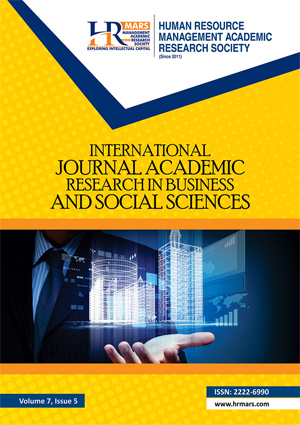
ISSN: 2222-6990
Open access
The paper seeks to examine organizational age effect on debt to equity ratio in Nigeria. The main objective of the study was to examine organizational age effect on debt to equity ratio. The relevant literature was reviewed for the purposes of this study. This study adopts the ex-post facto design. The paper uses secondary data only extracted from the Annual Reports and Accounts of 16 sampled firms out of the insurance companies in Nigeria. The target population of this study is the thirty-two (32) quoted insurance firms on the Nigerian Stock Exchange (NSE) and random sampling technique was used. Multiple regressions were used to analyse data and the hypotheses was tested at 5% significant level using Statistical Package for Social Sciences (SPSS). It was found that Organizational age does not have significant effect on Debt to Equity Ratio (p value = 0.737). The study recommended that managers should consider the organizational age effect on debt to equity ratio.
Adair, P. and Adaskou, M. (2015). Trade-Off Theory Vs Pecking-Order Theory and the
Determinantsnal of Corporate Leverage: Evidence from a Panel Data Analysis upon French SMEs (2002-2010). Cogent Economics and Finance, 3(1).
Adaramola, A. O. and Olarewaju, O. M. (2015). Determinants of capital structure in
Nigerian quoted composite insurance companies. Global Journal of Management and Business Research: C Finance, 15(10).
Adeyemi, S. B. and Oboh, C. S. (2011). Perceived Relationship between Corporate Capital Structure and Firm Value in Nigeria. International Journal of Business and Social Science, 2(19).
Akhtar, N., Bano, M. and Bano, S. (2016). Capital Structure Impact on Banking Sector
Performance in Pakistan. International Review on Management and Business Research, 5(2): 519-535.
Akingunola, R. and Oyetayo, O. (2012). Determinant of Financial Structure Decision in
Small and Medium Enterprises: A pilot Study of Selected Registered Companies in Nigeria. Journal of Economics and Finance, 3(1): 1-8.
Akinlo, O. (2011). The determinants of capital structure: evidence from Nigeria panel data.
African Economy and Business Review, 9(1): 1-16
Akinyomi, O. J and Olagunju, A. (2013). Determinants of capital structure in Nigeria.
International Journal of Innovation and Applied Studies, 3(4): 999-1005.
Akorsu, P. K. (2014). Testing the Pecking Order and Signalling Theories for Financial
Institutions in Ghana. Research Journal of Finance and Accounting, 5(16).
Aremu, M. A., Ekpo, S. L., Mustapha, A. S. and Adedoyin, S. I. (2013). Determinants of capital
structure in Nigerian banking sector. International Journal of Academic Research in Economics and Management, 2, 27-43.
Bakara, L. and Oladipupo, M. (2013). Insurance Industry: A Review. Journal of Pan African
Capital Research, 1, 1-2.
Baker, M. and Wurgler, J. (2002). Market Timing and Capital Structure. The Journal of
Finance, 57(1): 1-32.
Banerjee, S., Heshmati, A. and Wihlborg, C. (2000). The dynamics of capital structure.
SSE/EFI Working Paper Series in Economics and Finance, 333, 1-20.
Barclay, M. J., Smith, C. W. and Watts, R. L. (1995). The determinants of corporate leverage
and dividend policies. Journal of Applied Corporate Finance, 7, 4-19.
Barclay, M. J. and Smit, C. W. (2005). The Capital Structure Puzzle: The Evidence Revisited.
Journal of Applied Corporate Finance, 17(1).
Bassey, N. E. Arene, C. J. and Okpukpara, B. C. (2014). Determinants of Capital Structure of
Listed Agro Firms in Nigeria. European Journal of Business and Management, 6(27):92-98
Berger, A. N., Herring, R. J. and Szego, G. P. (1995). The Role of Capital in Financial
Institutions. Journal of Banking and Finance, 19, 393-430.
Booth, L., Aivazian, V, Demirguc-Kunt, A. and Maksmivoc, V. (2001). Capital structures in
developing countries. Journal of Finance, 56, 87-130.
Bradley, M., Jarrell, G. A. and Kim, E. A. (1984). On the existence of an optimal capital
structure: theory and evidence. Journal of Finance, 39, 857-878.
Casey, K. M. and Anderson, D. C. (1999). Examining the Impact of the Tax Reform Act on
Corporate Dividend Policy: A New Methodology. Journal of Financial Review, 34(3): 17-28.
Chandrasekharan, C. V. (2012). Determinants of capital structure in the Nigerian listed firms.
International Journal of Advanced Research in Management and Social Sciences, 1(2).
Chang, E. (1999). Capital Structure: Convergent and Pecking Order Evidence. Review of
Financial Economics, 1(1): 35-49.
Chechet, I. L., Garba, S. L., and Odudu, A. S. (2013). Determinants of Capital Structure in the
Nigerian Chemical and Paints Sector. International Journal of Humanities and Social Science, 3, 247-263.
Chechet, I. L and Olayiwola, A. B. (2014). Capital Structure and Profitability in Nigerian
Quoted Firms: The Agency Cost Theory Perspective. American International Journal of Social Science, 3(1).
Chen,
In-Text Citation: (Ugwu, Obasuyi, & Mbah, 2019)
To Cite this Article: Ugwu, K. O., Obasuyi, G. D., & Mbah, C. C. (2019). An Examination of Organizational Age Effect on Debt to Equity Ratio of Firms at the Nigeria Stock Exchange Market. International Journal of Academic Research Business and Social Sciences, 9(5), 542–554.
Copyright: © 2019 The Author(s)
Published by Human Resource Management Academic Research Society (www.hrmars.com)
This article is published under the Creative Commons Attribution (CC BY 4.0) license. Anyone may reproduce, distribute, translate and create derivative works of this article (for both commercial and non-commercial purposes), subject to full attribution to the original publication and authors. The full terms of this license may be seen at: http://creativecommons.org/licences/by/4.0/legalcode